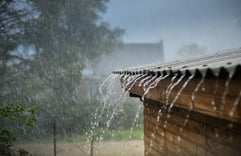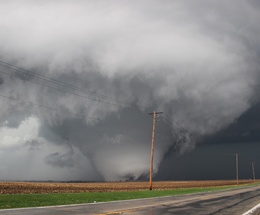 Nothing puts you on edge like a big storm. Whether it’s pounding rain and crashing thunder or a blizzard that knocks out the power for days, nasty weather can have you questioning your family’s fundamental security—and the steadfastness of the home that keeps you safe.
Nothing puts you on edge like a big storm. Whether it’s pounding rain and crashing thunder or a blizzard that knocks out the power for days, nasty weather can have you questioning your family’s fundamental security—and the steadfastness of the home that keeps you safe.
In fact, a really bad squall challenges all the things you usually take for granted: you have visions of your home being swept away, Wizard-of-Oz-style, on a gust of wind, with all your possessions—not to mention a major investment—airborne in one fell swoop.
Of course, it’s probably not going to happen like that. Most storm damage is a bit less dramatic, though no less anxiety-provoking. Leaks, ice dams, and fallen tree branches all present hazards that can make you and your family more susceptible to bad weather—and cost thousands of dollars to repair. Not all storm damage is avoidable, of course, but you can shore up a lot of vulnerabilities just by keeping a close watch over your roof maintenance. Lauren Pezzullo, guest blogger explains how.
Give Your Gutters a Good Flush
Your home’s gutters actually serve a purpose, and believe it or not, that function is not just to add to your home maintenance checklist. Your drainage system carries water and debris away from your roof and back onto the ground, where it belongs. But when your gutters are clogged, water backs up onto your roof and siding. This speeds up leaks and puts you at risk of more subtle problems, such as mold and roof rot. To keep your home in the clear, make sure to get up on the ladder at least twice a year—once in the fall, and once in the spring.
Put the Damper on Ice Dams
Icicles may look quaint hanging from the eaves of a gingerbread home, but in real life, they’re dangerous predictors of trouble to come. Icicles are usually a sign that your home has an ice dam—a buildup of ice layers from snow melting and refreezing when it hits the colder outer edges of your roof. Why’s that so bad? Ice is a lot heavier than snow—a one-inch layer of ice weighs about five pounds per square foot. Multiply that 20 or 30 times and you’ve got a real problem on your hands. Ice dams often block drainage systems and prevent runoff that could help lighten the load. And since roofs aren’t made to withstand standing water and ice, the dams can cause them to buckle, degrade, and leak over time. Ice formations are usually a sign that you have inadequate insulation or poor ventilation in your home. A roofing inspector can suss out both problems—and solving these issues means you’ll use less energy to heat your home, too! Win-win!
Don’t Take Your Time Fixing Missing Shingles
I don’t need to tell you that missing shingles are a problem. If you’re a homeowner, you probably already know that a broken or absent shingle will set you up for leaks. But unless you have water dripping onto your kitchen table, it’s one of those issues that’s easy to ignore. However, you may not be as leak-free as you think. Water infiltration can occur in attics or inside walls—places where you may not see it until you have a full-blown mold infestation on your hands. Do yourself a favor and hammer out replacement shingles sooner, rather than later. It could save you a lot of trouble next time it rains.
Undergo Regular Roofing Inspections
Speaking of missing shingles, did you know you should have your roof inspected every three to five years? Unless you’re fond of ladders, you probably don’t get up on your roof all that often. And that can make it hard to see issues that aren’t visible from the ground. But a qualified inspector can seek out tiny, nearly-invisible problems—ike pinhole leaks—which can cost you a lot if they’re not caught early on. Some roofing contractors even offer inspection services for free, so there’s no financial incentive to skip them—especially when a small repair now can save you the cost of a new roofing installation in a year or two.
Trim Back Nearby Branches
The old oak tree in the yard: a symbol of your deep familial roots and community connections. But when the winds blow, the branches may break, and when the bough breaks, your roof’s integrity is not far behind. Branches carried at high wind speeds can slam into your roof, causing damages untold. Protect your roof by hiring an arborist—a good tree guy will trim overhanging branches and inspect for rotting tree trunks that could be knocked over by one bad blow. A little preparation may not reel in every little fear, but you’ll definitely rest easier the next time it storms. Bring on the rain!
Lauren Pezzullo is a writer, editor, and musicophile who’s passionate about vegetarianism and sustainable eating. As an editor for Modernize, she writes about energy-efficient living in the home. She’s currently writing her debut novel.
SOURCE: WEST BEND, Scott Stueber on May 16, 2017 9:00:00 AM
 While operating a lawn mower is a common task this time of year, it can be dangerous. Flying debris, moving and hot parts, and errors in judgment can quickly lead to serious injury.
While operating a lawn mower is a common task this time of year, it can be dangerous. Flying debris, moving and hot parts, and errors in judgment can quickly lead to serious injury.

